Travel & Tourism Digital Marketing Trends in the USA
Like digital marketing, travel and tourism is an industry that is constantly evolving, be that due to emerging consumer trends, destination popularity or economic/political events.
The only trend which remains reliably predictable is the seasonal spike we see in January each year for people ‘booking’ their holidays (though this saw some changes to seasonality post-pandemic due to people not being able to travel for so long, this has since normalised).
If you're a UK-based travel business looking to break into or increase your market share in the USA, keeping up with the latest trends and ways US consumers search and on which platforms can be challenging. You must be on top of your game to stay up to date and ensure your campaign strategy achieves your KPIs.
Luckily for you, as an award-winning travel digital marketing agency, we constantly monitor and analyse the latest travel digital marketing trends in the UK and abroad. We’ve broken down the USA's current and emerging trends that you should be considering as part of your digital marketing strategy.
If you’re not social, get social!
Social leads in media consumption across travel consumers
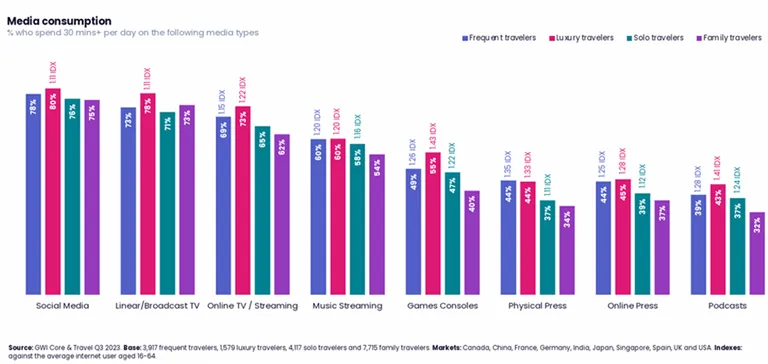
According to GWI’s panel survey, frequent travellers (global) heaviest media consumption beyond TV/streaming, is social media. It’s not surprising therefore, given how visual social platforms are and how heavily they’ve all leant into video, that social media heavily influences where people choose to travel, be this via social media advertising, organic posts or spread of word of mouth across the different platforms.
Social influences travel purchase decisions
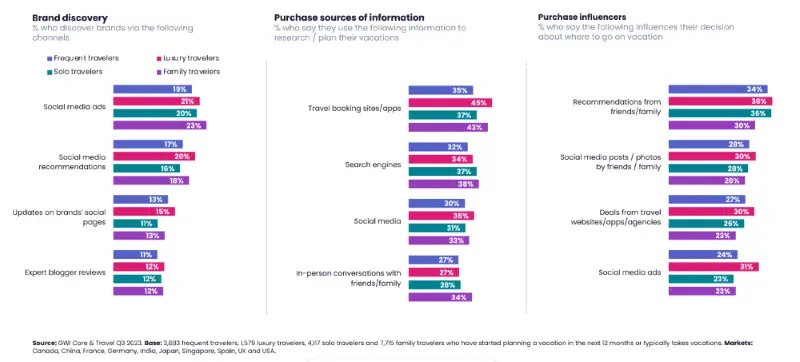
Meta platforms dominate social reach of travellers
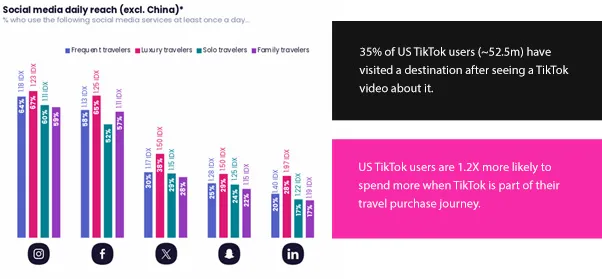
Meta owned platforms Instagram and Facebook came out on top across travel panelists surveyed for usage, however, whilst TikTok wasn’t included within the survey, it has also been reported to influence travel bookings.
Respect the platform and play to its strengths
The most successful social media campaigns, be that organic or sponsored, are those which encompass the nature and behaviours of its environment into its content. However, there’s the nature of the platform and then there’s the nature of its placements and the type of content you should feature across the platform. Here’s a few examples of both for the top social environments for travel and tourism.
TikTok
Deemed by themselves as a video entertainment platform, which due to behaving a little like YouTube in that it’s typically a sound on environment, you don’t get a lot of dual screening so it’s a fair assessment. However, it's also become a bit of a social search engine (like YouTube and Pinterest) in that people seek answers to their questions via the content available. This is perfect for pushing the following types of video content on a national scale for your target audience (though geo targeting capabilities are constantly being refined, reserve this platform for upper-mid-funnel larger scale reach):
- SEO inspired content in short-form video (15” or less) such as 'top 5 resorts in x', or ‘5 best places to visit in x', is great inspiration led content which can also be transferred across to Instagram reels. This aids upper funnel research and inspiration, igniting interest even before someone’s search for their next travel destination has begun.
- Cultural and social relevance: Scaling your reach and engagement by leaning into ‘TikTok trends’ via trending sounds, music, dances and lip syncing content. These are great to utilise voice overs, staff/influencer or UGC led creatives.
Instagram/Facebook
- Much of the aforementioned content can be re-used across reels and feed placements.
- Across stories, try and keep this much more ‘action’ driven e.g. featuring promotional offers, new destination/resort launches. Whilst fantastic for reach due to the volume of users and multiple placements, you can take advantage of mid-lower funnel targeting and action driven content as users are very used to clicking out of these platforms to take action with good conversion measurement capabilities.
- Lead with video, but due to various placement offerings you have the potential to utilise still images/GIFs across single images, carousels, collections, instant experiences and slideshow ad formats (in addition to those mentioned above). You always want to aim to have at least 2-3 creatives running within each ad set at any one time as a minimum, so the algorithm has more to test and determine which drives the best performance.
- Leverage dynamic capabilities: An ad format which is still current and worth taking advantage of is travel ads (dynamic ads) which utilise a product feed to dynamically pull images, hotel pricing/flights etc… to drive lead gen/sales.
AI For Convenience & Creativity

Whilst AI is not new to the travel industry as airports are already utilising things such as facial content recognition for security, and hotels have been making use of AI for check-ins (particularly when it helps to have multi-lingual services available), its usage is increasing to support content creation and marketing activities. It can be a costly exercise to showcase a destination to your target audience, from video production to staff/videographer travel expenses.
Despite how knowledgeable your business/staff are in the destinations/accommodation you sell, there’s nothing quite like seeing a teaser of what your holiday could look like before booking to sway your purchase decision. This is where marketers have been experimenting with AI to pull together creative assets to showcase across their websites, virtual brochures, social posts and digital ads. Even accessible creative tools such as Canva have been incorporating AI into their service offering to aid with content creation.
US travellers have also been tapping into AI to help with planning their trips (17% of Americans used AI for travel planning in 2023). Consider how your business and marketing strategies can be making use of AI to enhance user experience and bring your services/destinations to life through your advertising.
U.S. Travel Consumer Trends
The Conference Board survey of consumer attitudes reported in their latest data release (April 2024) that 1 in 5 Americans plan to travel internationally in the next 6 months (compared with 1 in 10 in 2019), which is up 20% compared with pre-pandemic interest.
Americans' interest in international travel has increased
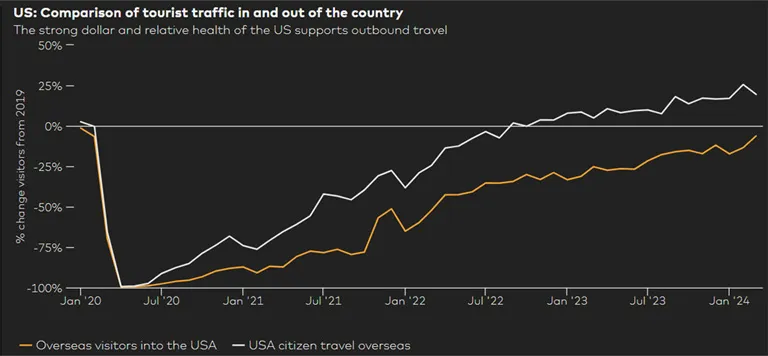
Trending destinations and cultural influence
Similar to TV programs influencing travel (read more about this in my Love Island blog post) sporting events also have a huge influence over travel (on a larger scale) so whilst it may be un-expected, globally Munich was reported to be the most popular destination globally for bookings, which is linked to Euro 2024. Additionally, events such as the Olympics 2024 will likely increase European travel as France offers a combination of city and beach holiday options and is a short flight away from other European destinations such as the UK (London) and Greece.
The Caribbean, Europe and Japan are trending destinations
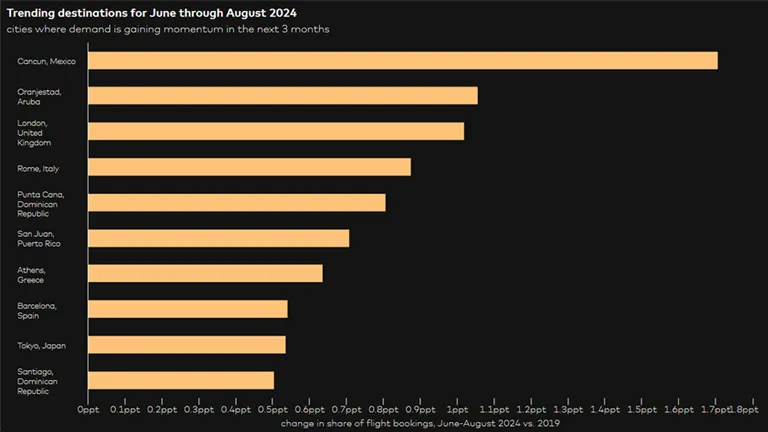
Whilst primarily beach destinations are top of mind for Americans' international travel inspiration (with the exception of the UK, though there are some gorgeous beaches…but I’m bias being a Brit who would highly recommend proper fish and chips at the beach), Japan continues to be a rising destination of interest for US travel bookings.
North American passenger arrivals in Japan continue to rise

'Quiet vacations' are emerging, particularly with Millennials
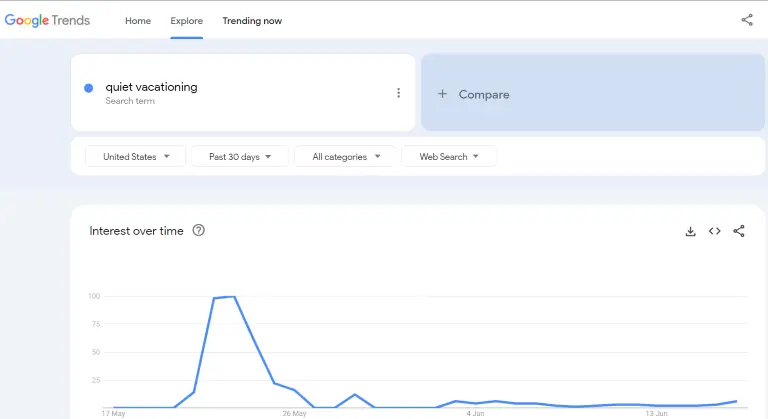 Photo credit: Google Trends
Photo credit: Google Trends Recent news headlines in the US last month (June) have been surrounding the topic of ‘quiet vacationing’ (essentially people working abroad) with the following breakout searches:
- millennials quiet vacationing
- quiet vacationing meaning
- what is quiet vacationing
- millennials are quiet vacationing
With the rise in flexible/remote working post-pandemic, it’s no surprise people are opting to tie in holidays and PTO whilst working to experience more of the world. Obviously, we don’t condone going against any company policies to do so, but with more businesses offering a ‘work from anywhere’ type benefit/policy, companies within the travel and tourism industry should consider that people are not always travelling for ‘business or leisure’, but occasionally both and therefore, accommodating this demand with amenities/itineraries/accommodation, is beneficial to meeting consumer demands.
Make data-driven decisions to lead your marketing strategy
Whether you’re a short-term rental provider, airline, hotel resort, travel agent or other type of travel or leisure business, there are digital data insights within the above you can layer over your own business data. This will help shape your digital media marketing across PPC, SEO, social and more (consider the creative for your above-the-line activity even in the likes of print, OOH and TV), and there’ll be even more to emerge this year and beyond. Keep an eye out for trending travel updates from us (or save this post).
If you would like to discuss your travel digital marketing needs, drop us a message.
Happy strategising and perhaps, you’ll find even more inspiration booking a little holiday for yourself!

